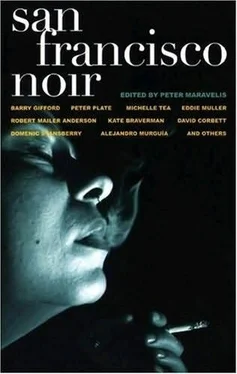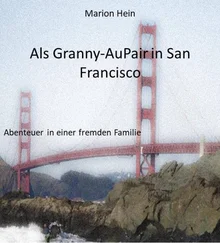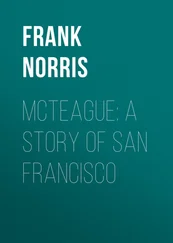Upon jumping-whether west, toward the ocean and into the sunset, or east, toward the bay and into a view that commands half the city-if a body didn’t have a heart attack on the way down, the impact at sea level was almost certain to do the job; failing these, one could be swept out to sea and drowned, or die of exposure in the chill waters. Sharks, too, were known to lurk below. In any case, a suicide attempt from this bridge virtually contracted to be beautiful and deadly, a sure combination.
For some time there had been editorial campaigns, meetings, and committees about doing something to prevent these precipitous exits, but the taxpayer’s good money being short, and other problems more pressing within the municipality, and the lack of any effective preventive technique hobbled and bogged down any real progress toward airbrushing this stain off the reputation of the city’s most famous land-mark. The thrust of such prophylactic thinking some took to imply that any time Joe Blow so much as looked at the bridge, all other factors being equal, he must be nearly overwhelmed by an urge to kill himself. These people would have it that such malefic urges must occasionally torque at the breast of the most established citizen, as well as the least, and that such urges are an actual furniture of good citizenship. This eccentric opinion, unexpectedly amplified, moved those sensitive organs of citizenship, the newspapers, to reflect noisily that the citizen might prefer to be insured against the possible or at least facile realization of his own self-destructive impulsions.
Further speculation indicated that this beleaguered citizen, if not himself untimely deceased, may have lost to the bridge someone intrinsic to his social circle, a person handy, for example, at conversation, which, though thought to be excruciatingly dull while its perpetrator was quick among his peers, has since by virtue of its absence been noticed as somehow essential to the arrangement of chairs at dinner. Such a host and the citizenry in general might like to be relieved of this sort of nuisance by the knowledge that when they do happen to rest their eyes upon the bridge, they will see it hung all bristling vigilant with nets, pincers, inner tubes, inflatable vests, lifeguards, searchlights, hooks, pikes, concertina wire, rubber sacks, plastic shields, helipads, etc., in order that unseasonable defection might be reasonably inhibited.
Personal motivation manifested itself only in the most ephemeral ways, as speculation printed and broadcast, editorials, political gambits, research-grant hustles, and social-maze theory, until two entirely unrelated events rendered it simultaneously germane and academic. The first was the unfortunate suicide committed by a young woman whose senseless body, plunging from the bridge at nearly ninety miles per hour, crashed through the foredeck and hull of a small boat as it sailed out from under the looming structure. The boat sank in an appalling three minutes, and constituted a significant loss to its captain who, alone on board at the time, was rescued by a passing fishing vessel. His cargo, however, was not saved. This ironic chattel consisted of little wooden replicas of the famous bridge itself, manufactured in various sizes, by hand, in cottages up and down the coast, regularly collected and shipped by the captain to the city for distribution and sale as souvenirs. The accident set these little bridges adrift by the hundreds. Whole and in pieces, left to the whims of the sea, they littered the beaches, inlets, piers, and marinas of bay and coast for months, as to all who might come by them grim, miniature reminders of the infamous utility of the giant original. This incident provoked much discussion, of the order that something-anything-be done about the bridge’s ominous potential for death.
The second incident was the perfection and commercialization of a patented gravity forcefield. Within a year of its introduction, and less than six months after the dispersion of the little wooden bridges, the city government caused to be installed a forcefield network which controlled the entire length of the bridge. Along each side of the span, this marvel extended a sort of tube of weightlessness designed to catch and hold in suspension any individual or thing that might happen into its scope, until such time as the authorities might arrive to fish out the wayward article. Though in any case an effective deterrent, the collateral notion seemed to be that a potential suicide suspended in the invisible grasp of this device would be severely embarrassed by his public display, more or less as if he’d been clapped into the stocks in the town square with a large capital “S” painted on his forehead, and thus inhibited from renewing his attempt to end his life in so public a fashion. Accordingly, in a fit of legislated avuncular-ity, no penalty, beyond mandatory psychiatric counsel, was proscribed for a person chagrined in this manner.
From the very first day of construction and installation until well beyond the last, pickets who represented themselves as members of the “Right to Die Coalition” conducted peaceful demonstrations on or about the bridge. Their case was that suicide is a private act, over which no entity outside the individual can exercise judgment; that one should be as responsible to one’s own person in a self-destructive mode as in a constructive one; that this particular bridge was as good a site at which to perpetrate this right as any other, and, in fact, being far more effective than most, was admirably suited for it; and, furthermore, to legislate public suicide out of the public eye was merely to sweep yet another fact of life under some sort of moral rug.
The nearly daily scenes of organized protest were marred only occasionally. A young man, haranguing workmen not to aid in depriving the world of one of its most useful manmade creations, was carried away by the emotion of his appeal and made what the newspapers impatiently dubbed a salto da fe -a leap of faith. As might have been expected, two or three people, each apparently acting on the assumption, perhaps cherishing the hope, that he might be the last on record as having done so, flung themselves from the bridge during the final hours of construction.
In the weeks following the completion of “Project: Wait!”, much detritus collected in the two fields, for they were extremely sensitive, and just as indiscreet. The trash usually found along a freeway or sidewalk now floated alongside the bridge as well; this included the obvious beer cans, muffler clamps, and hubcaps-but the devices were so effective as to disallow the whimsical escape of so much as a cigarette butt, not to mention loose stones, newspapers, condoms, and rain, so that this famous bridge with its famous forcefields became even more famous for its asteroid belts of refuse.
At first the bridge authorities, publicly announcing that they were working on the problem, quietly turned off the fields once a week in the middle of the night at maximum flood, thereby plummeting the trash into the bay and sweeping it out to sea. But environmentalists and a couple of suicides soon got wind of this rather efficient practice and forced an injunction against it. Subsequently a special cleanup crew with unique machinery and techniques was designed and put into service.
As soon as the effect on roadside detritus achieved notice, individual humans began to experimentally, then playfully, throw themselves into the forcefields and squirm around in them, gleefully avoiding the especially contrived retrieval devices that were cast after these less than hapless and not particularly despondent victims. These people made the additional discovery that one could actually “swim” a full circle-vertically, or in any other direction-like a looping airplane. Reports varied, but one likened the experience to writhing in a large volume of transparent gelatin, excepting, of course, the degree of fluidity and the magnificent view. Firsthand testimonies were duly monkeyed in the tabloids ( CREEPS DOMINATE FIELDS was one headline I remember) with the predictable results that the authorities spent more and more time and money skimming the adventurous out of the forcefields. These policing efforts were soon overwhelmed and, finally, so popular had “getting jumped” become, every-body but the newspapers realized that, although throwing oneself with abandon off the bridge into its forcefields may be vulgar, it certainly did no one any harm. Thus it came about that on any given sunny Sunday, as the bridge teemed with automobiles full of onlookers, any number of people might be found wriggling or sunbathing along either side of the entire length of it, with a population bias on the western or “sunset” side. And the police more or less looked the other way. To have spent an hour or so “jumped” or “suspended” on Sunday afternoon became a socially acceptable pastime, especially among the young, whose avant guard jumped while drunk or stoned. Certain lengths of the span soon became popular hangouts for the besotted, while other stretches were more popular with the stoned. It became not uncommon for a jumpee to find himself floating in company with a suspended quantity of vomit, or among a slowly dispersing nebula of stems and seeds.
Читать дальше












